AS A PART OF ‘ARTISTIC LICENSE: SIX TAKES ON THE GUGGENHEIM COLLECTION,’ THE FIRST ARTIST-CURATED EXHIBITION AT THE SOLOMON R. GUGGENHEIM MUSEUM, ‘NON-BRAND (非品牌)’ CURATED BY CHINESE ARTIST CAI GUO-QIANG PROVIDES MUSEUMGOERS A CHANCE TO PERCEIVE THE ARTS WITHOUT ANY DISTRACTION FROM WORDS
TEXT: PIM-ORN SUPAVARASUWAT
PHOTO: DAVID HEALD © SOLOMON R. GUGGENHEIM FOUNDATION EXCEPT AS NOTED
(For English, please scroll down )
Non-Brand (非品牌) คิวเรตโดยศิลปินชาวจีน Cai Guo-Qiang เป็นนิทรรศการย่อยภายใต้ร่มใหญ่ของนิทรรศการ Artistic License: Six takes on the Guggenheim Collection ที่ Solomon R. Guggenheim Museum นิวยอร์ก นี่เป็นครั้งแรกที่ Guggenheim สาขานิวยอร์ก เชิญศิลปินมาเป็นภัณฑารักษ์นิทรรศการ ศิลปิน 6 คน จะต้องเลือกงานศิลปะในคอลเล็คชั่นของมิวเซียมมาจัดแสดงโดยแต่ละคนจะได้พื้นที่เป็นผนังตามจุดต่างๆ ของทางเดิน spiral ทั้ง 6 ชั้น ซึ่งในส่วนของ Cai เขานำผลงานกว่า 80 ชิ้น จากศิลปินกว่า 30 คน มาแขวนเต็มพื้นที่ผนังทางเดินชั้น 1 (คนที่สายตาสั้นอาจจะดูชิ้นงานที่ติดอยู่สูงลำบากเสียหน่อย) ผลงานหลายชิ้นเป็นงานศิลปะชิ้นสำคัญในประวัติศาสตร์ศิลปะตะวันตก ซึ่งเป็นโอกาสชั้นดีที่ผู้ชมจะได้พิจารณาผลงานชิ้นสำคัญของศิลปินยุคโมเดิร์นด้วยตนเอง
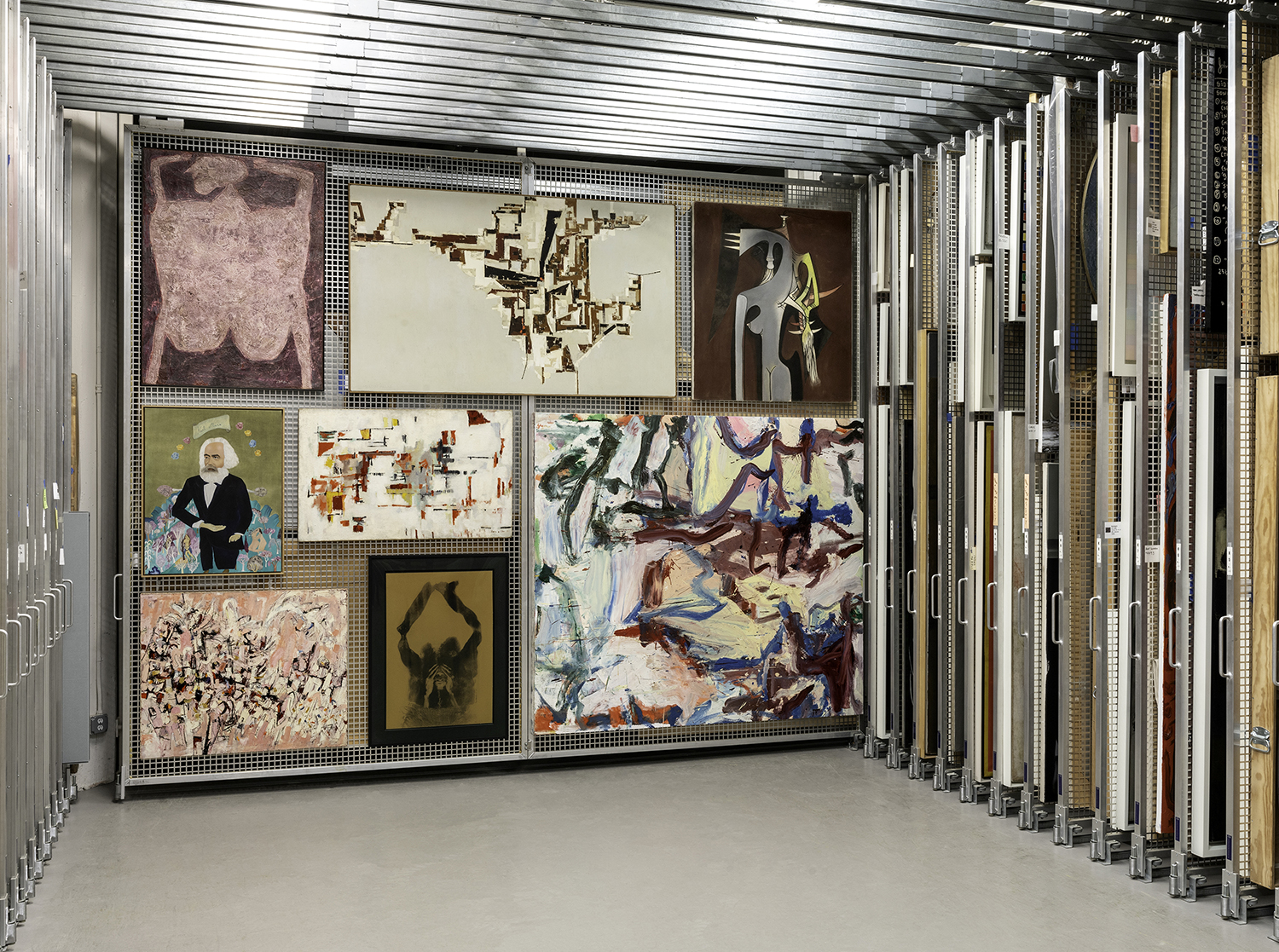
Works from the Guggenheim Museum’s collection in storage, by (clockwise from top left) Jean Dubuffet, Martin Barré, Wifredo Lam, Willem de Kooning, David Hammons, Paul Wonner, Cecilia Vicuña, and Maria Helena Vieira da Silva. Barré, Dubuffet, Lam, and Vieira da Silva © 2019 Artists Rights Society (ARS), New York/ADAGP, Paris; De Kooning © 2019 The Willem de Kooning Foundation/Artists Rights Society (ARS), New York; Hammons © David Hammons; Vicuña © Cecilia Vicuña; Wonner © Estate of Paul Wonner and William Theophilius Brown, Crocker Art Museum, Sacramento.
Cai เป็นศิลปินชาวจีนที่พำนักและทำงานอยู่ในนิวยอร์ก เคยมีนิทรรศการที่ Guggenheim หลายครั้งทีเดียว และเป็นที่รู้จักจากเทคนิคการทำงานศิลปะด้วยดินปืน เขาให้ความเห็นต่อการจัดนิทรรศการครั้งนี้ไว้ว่า “ผมต้องการคิวเรตนิทรรศการที่ตัวผลงานมีอิสระจากดีกรีของศิลปินผู้สร้าง” โดยนำผลงานของศิลปินคนสำคัญๆ แต่จงใจเลือกผลงานกลุ่มที่ไม่ค่อยถูกยกว่าเป็นชิ้นสำคัญมาจัดแสดง ศิลปินอธิบายว่า “ทุกๆ มิวเซียมมีผลงานชิ้นสำคัญที่น่าดึงดูด แล้วคุณก็จะเจอป้ายแคปชั่นงานทุกหนทุกแห่ง อธิบายว่างานชิ้นไหนสำคัญ สำคัญยังไง แต่เชื่อผมเถอะ มันมีชิ้นที่น่าสนใจกว่านั้นเยอะในคอลเล็คชั่นของมิวเซียม”
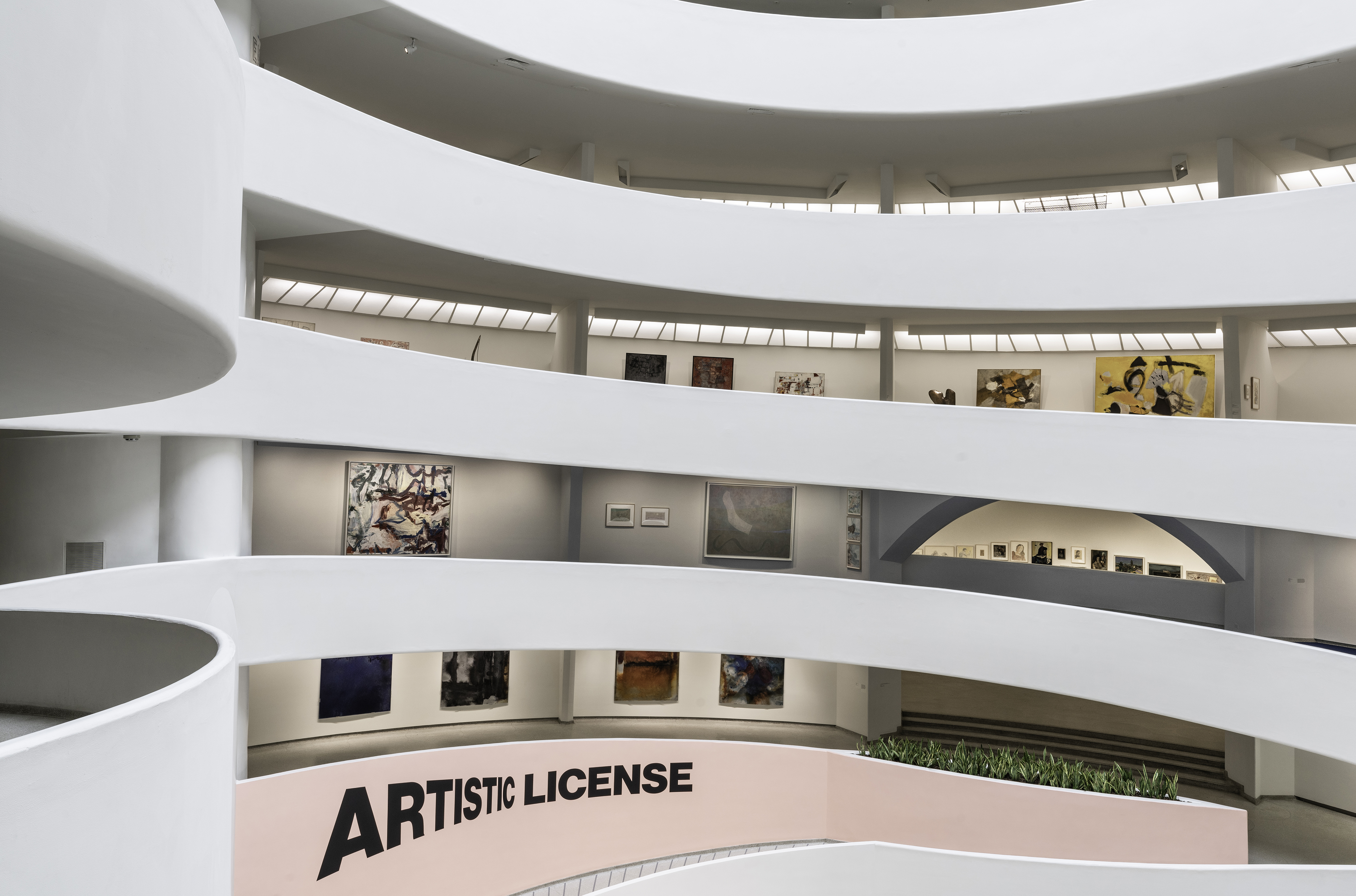 Installation View: Artistic License: Six Takes on the Guggenheim Collection, Solomon R. Guggenheim Museum, New York, May 24, 2019 – January 12, 2020
Installation View: Artistic License: Six Takes on the Guggenheim Collection, Solomon R. Guggenheim Museum, New York, May 24, 2019 – January 12, 2020
ผลงานที่ Cai นำออกมาจากคลังของมิวเซียมเป็นผลงานโดยศิลปินที่เราคุ้นชื่อกันดี ทั้ง Kandinsky, Matisse, Klimt และ Picasso บริเวณด้านซ้ายของผนัง เป็นกลุ่มผลงานสีจางๆ ภาพสเก็ตช์สรีระมนุษย์ ภาพ still life และภาพร่างดินสอจางๆ ที่แทบจะมองไม่เห็นบนกระดาษร่างสีเหลือง ท่ามกลางภาพเหล่านี้ ยังมีภาพดอกเบญจมาสสีอ่อนๆ แต่เต็มไปด้วยรายละเอียดของศิลปินที่มีชื่อจากงานเชิงนามธรรมอย่าง Piet Mondrian และภาพ still life ของ Mark Rothko ประกอบอยู่ด้วย เมื่อผู้ชมมองไล่ผลงานไปยังทางด้านขวาของกำแพง จะพบกับผลงานที่มีสีเข้มขึ้นเรื่อยๆ ค่อยๆ แปรเปลี่ยนไปเป็นงานศิลปะเชิงนามธรรมที่โดดเด่นสะดุดตา งานศิลปะทั้งหมดที่กล่าวมานี้ถูกแขวนเรียงติดชิดกันจนแทบจะระบุชื่อชิ้นงานไม่ได้ แม้จะมีป้ายเล็กๆ และตัวเลขคอยระบุตำแหน่ง / ชื่อผลงานติดอยู่ มันก็ยังบอกยากอยู่ดีว่างานชิ้นไหนชื่ออะไรและใครวาด ปฏิเสธไม่ได้ว่า คงมีผู้ชมหลายๆ คนที่ไม่อาจทราบได้ว่าตนเองนั้นกำลังชมภาพอะไรอยู่กันแน่ แต่นั่นแหล่ะ คือความเป็นอิสระที่ศิลปินกล่าวถึง
การแขวนผลงานไว้เดี่ยวๆ เว้นสเปซรอบๆ ชิ้นงานตามขนบทั่วไปของการติดตั้ง อาจทำให้เราได้เพ่งพิจารณาผลงานโดยง่าย แต่การติดแขวนงานแบบ Salon ที่ทุกๆ ภาพถูกแขวนติดชิดกัน ก็ทำให้เกิดความสัมพันธ์บางอย่างขึ้น นั่นคือมันเปิดโอกาสให้ผู้สนใจหรือนักเรียนศิลปะ ได้พิจารณาผลงานในแบบอื่น แบบที่เป็นอิสระจากราคาของชิ้นงาน ชื่อเสียงและความโด่งดังของศิลปินผู้สร้างผลงาน สิ่งต่างๆ เหล่านี้ถูกขจัดทิ้งไปเพื่อสร้างความเท่าเทียมกันให้กับผลงานทั้งหมดที่แขวนอยู่รวมกัน
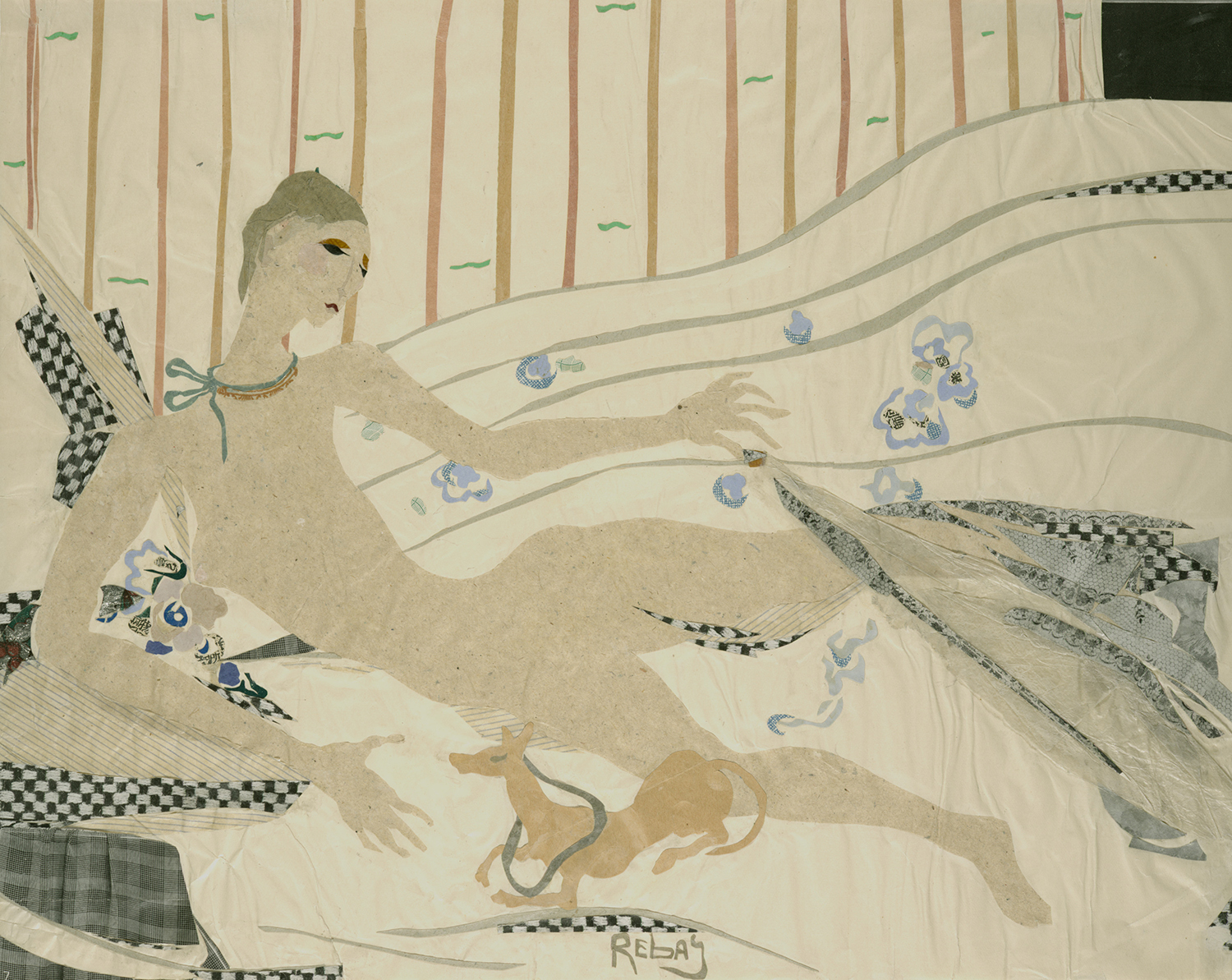
Hilla Rebay, The Dog (Le chien), n.d., Paper collage, 34.9 x 43.7 cm, Solomon R. Guggenheim Museum, New York, Solomon R. Guggenheim Founding Collection, By gift 41.576 © 2019 The Hilla von Rebay Foundation
เมื่อเราเผชิญหน้ากับกำแพงที่เต็มไปด้วยจิตรกรรมจำนวนมากขนาดนี้ ถ้าสายตาของเราไปหยุดอยู่ที่ผลงานชิ้นใดเป็นพิเศษนั้นก็เท่ากับว่า เราเป็นผู้แยกชิ้นงานนั้นออกมาจากชิ้นอื่นๆ ด้วยตัวเราเอง และการหาคำตอบว่า เพราะเหตุใดเราถึงสนใจงานชิ้นนั้นเป็นพิเศษก็อาจจะเป็นกุญแจในการสร้างความเข้าใจในตัวของเราเองมากขึ้นก็เป็นได้ Alain de Botton นักปรัชญาวัฒนธรรมป๊อป เคยเสนอความคิดไว้ว่า คนเรามักจะเลือกมอง หรือถูกดึงดูดโดยงานศิลปะบางชิ้นที่มีบางสิ่งที่เราไม่มี ในนิทรรศการนี้ที่เปิดโอกาสให้เราได้เลือกผลงานที่จะรับชมด้วยตัวเอง Cai ผลักดันให้เราพัฒนาความสัมพันธ์ระหว่างตัวเราเองกับงานศิลปะไปพร้อมกับสำรวจตัวเองว่าจริงๆ แล้วตัวเราหลงใหลงานศิลปะแบบไหนกันแน่
‘Artistic License: Six takes on the Guggenheim Collection จะจัดแสดงจนถึงเดือนมกราคม 2020 นี้

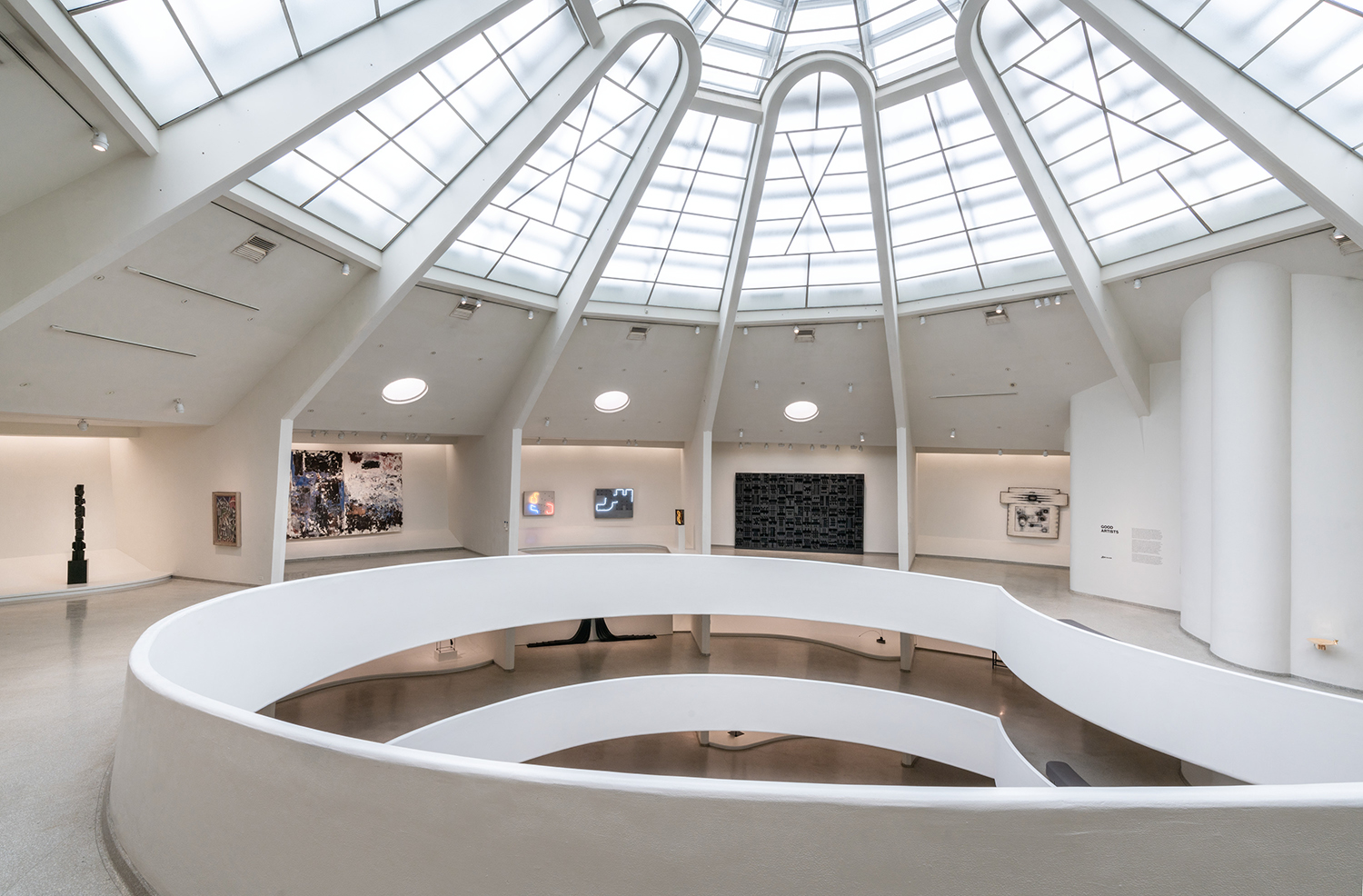 Installation View: Artistic License: Six Takes on the Guggenheim Collection, Solomon R. Guggenheim Museum, New York, May 24, 2019– January 12, 2020
Installation View: Artistic License: Six Takes on the Guggenheim Collection, Solomon R. Guggenheim Museum, New York, May 24, 2019– January 12, 2020
Cai Guo-Qiang’s exhibition, Non-Brand (非品牌), requires much squinting and neck-craning. His show is a part of the exhibition ‘Artistic License: Six takes on the Guggenheim Collection’ at the New York City branch of the museum, which will run until January 2020. The exhibition is the first artist-curated exhibition at the Guggenheim where six artists have been invited “to make selections to shape a discrete presentation, one on each of the six levels of the rotunda.” For his presentation, Cai has selected over eighty works by more than thirty artists to display up, down and across the wall on the first-level rotunda, salon-style. While it may prove a challenge for the short-sighted, the hanging style chosen for works by artists who have defined the Guggenheim collection (as well as major artistic movements) does leave the museum-goers with a novel experience of the modern masters.
Cai is a New York-based, Chinese artist who has had multiple solo exhibitions at the museum and is well known for using gunpowder in his work. Commenting on his curatorial approach, Cai says, “I want to have an exhibition without stars or brands.” He has selected works by famous artists that are not necessarily in their signature styles. Cai explains, “Every museum has iconic works of attraction. You’ll see plaques everywhere telling you about the classic and important artworks to see. But when you go into the storage you see more.”
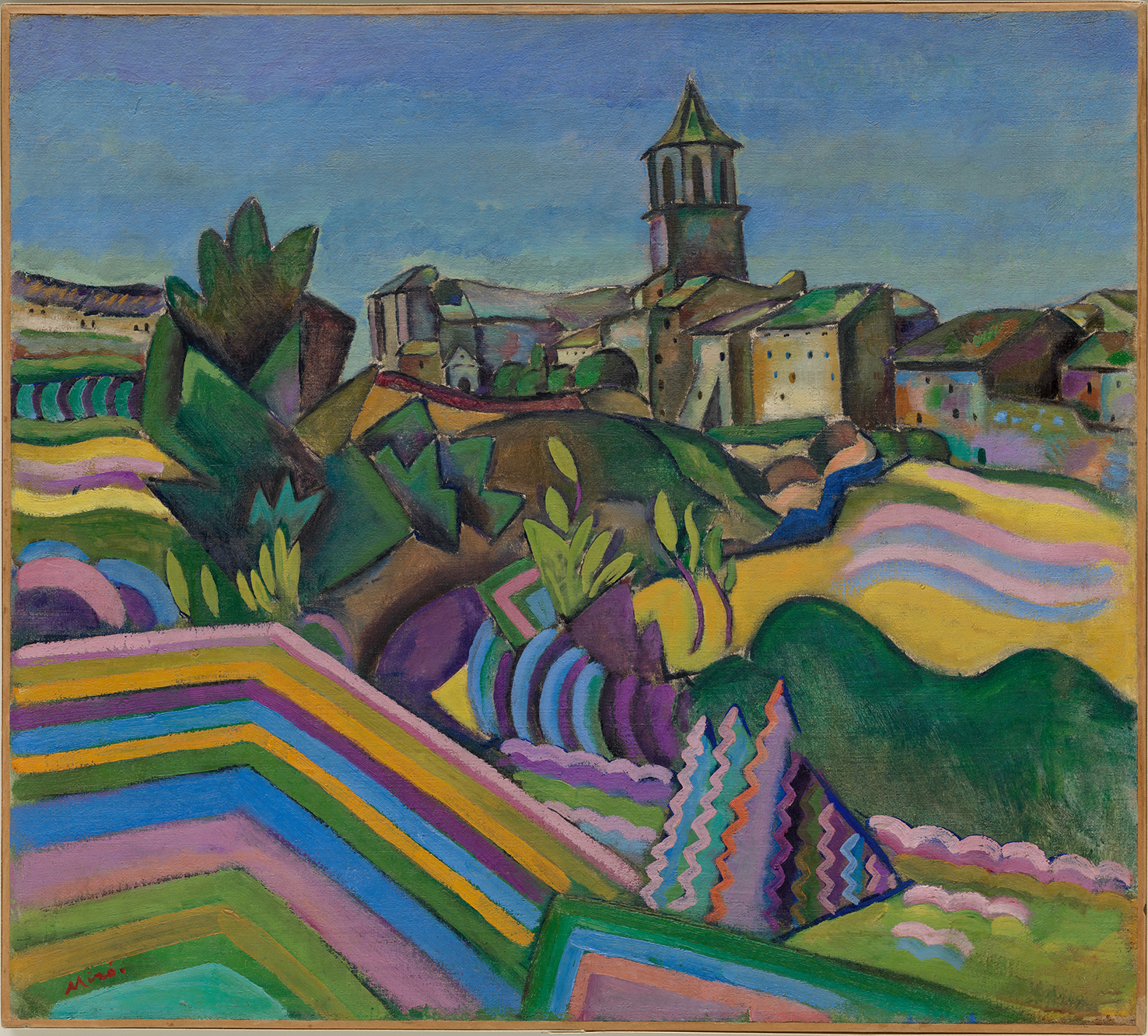
Joan Miró Prades, the Village (Prades, el poble), summer 1917, Oil on canvas, 65 x 72.6 cm, Solomon R. Guggenheim Museum, New York 69.1894, © 2019 Successió Miró / Artists Rights Society (ARS), New York / ADAGP, Paris
What Cai has dug up from storage includes unassuming pieces by artists who have come to be known only by their last names, such as Kandinsky, Matisse, Klimt and Picasso. To the left of the wall are paintings in muted colours, nude studies, still-life images and sketches done in pencil barely visible on the yellowed paper. Among these works is a softly-hued, detailed drawing of a chrysanthemum by, of all people, Piet Mondrian and a still life by Mark Rothko. The pieces get darker as you roam your eyes to the right where abstract, bolder works crowd together. It’s hard to tell, however, which work is whose and the gallery guide with its blank rectangles and small numbers indicating the position of each work is still hard to match up with what’s on the wall. Some viewers are left not knowing exactly what they are looking at—and it’s freeing.
While hanging a single painting and generously giving it ample wall space does eliminate distractions, which might get in the way of deep contemplation, the crowded, salon-style hanging and its connotative association with the academies and student-artists can also free viewers from other things: the prices of the works, the names of the artists, their reputation – all of these things are forgotten in a democratising display.
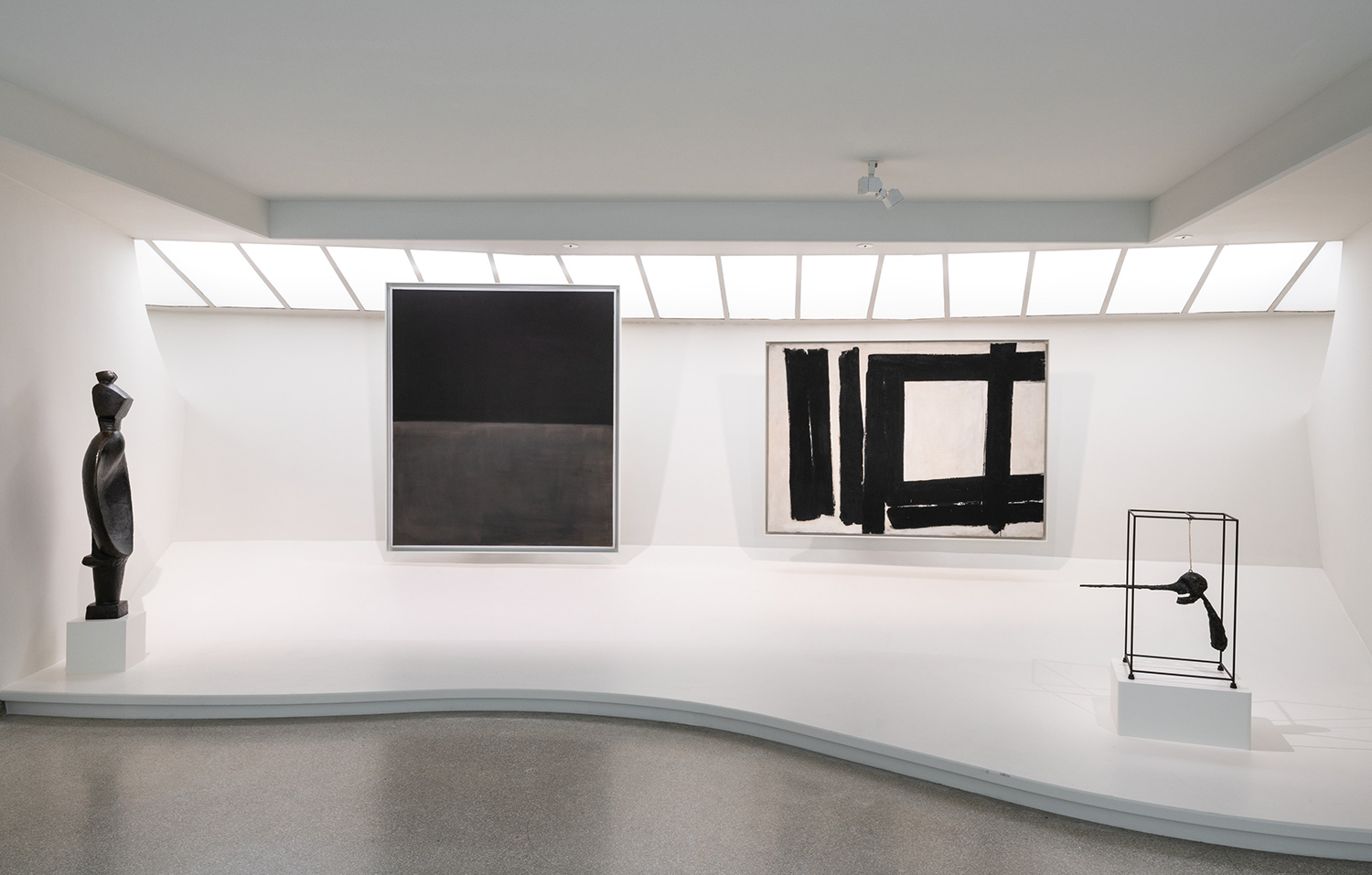
Installation View: Artistic License: Six Takes on the Guggenheim Collection, Solomon R. Guggenheim Museum, New York, May 24, 2019– January 12, 2020
When we are confronted by a wall of paintings, if our eyes are drawn to something, it is we ourselves who have isolated that piece of work, and for our own reasons. Contemplating what these reasons may be could give us a better understanding of ourselves, as pop-philosopher Alain de Botton suggests, we often have a compensatory relationship to works of art, that is, we are frequently drawn to those works that contain exactly what we lack. By virtue of giving viewers a chance to decide for themselves what to look at, Cai’s salon-style exhibition encourages us to develop a more personal relationship to art as we reflect upon our own attraction to particular works.

